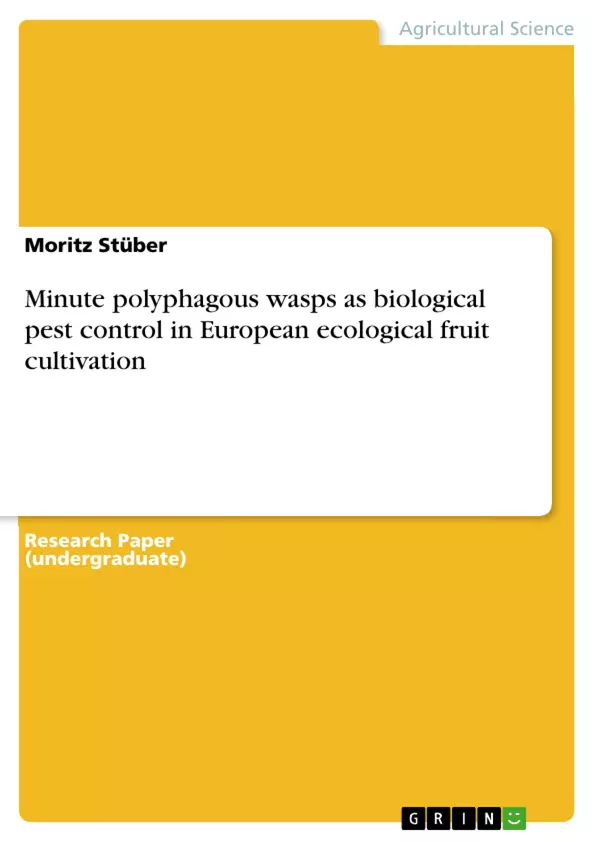Mass releases of parasitic minute polyphagous wasps is a common biological pest control practice across the world. The application can reduce chemical insecticide use and therefore contribute to a more sustainable agriculture. Nearly all frequently used species derive from the genus Trichogramma. These wasps are released on several Million hectares of agricultural production, particularly in maize cultivation. This report is aiming to give an insight into a growing system, where Trichogramma practices are still under development. With regards to the application density, efficacy, applied species and environmental risks of Trichogramma in European ecological fruit cultivation was reviewed. The common application methods are lacking consistent results and pest control efficacy, since orchards differ greatly from the usual grain field cropping system. Three research directions to increase efficiency can be distinguished: new application methods (1); environmental attributes that favour Trichogramma (2) and suitable Trichogramma (mixtures) species (3). Development of equipment, suitable to disperse Trichogramma eggs more equally between rows is needed. A nozzle fan, spraying Trichogramma eggs, seemed to decrease costs and labour force by simultaneously increasing pest control consistency. Flower strips, particularly by containing buckwheat and mustard, can increase the longevity and fecundity of the wasps, leading to a better pest control performance. Local Trichogramma species should be preferred, as they are used to the climatic conditions and contribute to agroecological practices. The risk of mass releases on non-target insect species must be surveyed continuously. No significant effects were found, but off-field emigration does happen and needs to be monitored. The research implies the potential of Trichogramma to be used as an agroecological practice, being able to contribute to insecticide reduction. However, many results still need to be tested under commercial conditions.
Inhaltsverzeichnis (Table of Contents)
- Abstract
- 1. Introduction
- 2. Minute polyphagous wasps as biological pest control...
- 2.1. Biology
- 2.2. Global perspective
- 2.3. Application in orchards
- 3. Discussion
- 4. References
Zielsetzung und Themenschwerpunkte (Objectives and Key Themes)
This report investigates the effectiveness of using minute polyphagous wasps for biological pest control in European ecological fruit cultivation. It aims to assess the application range, limitations, risks, and suitability of this method as an agroecological practice.
- The role of Trichogramma wasps in biological pest control
- The effectiveness of Trichogramma applications in different agricultural settings
- The environmental impacts of Trichogramma use
- The potential for Trichogramma to contribute to more sustainable agricultural practices
- The challenges and opportunities for using Trichogramma in ecological fruit cultivation
Zusammenfassung der Kapitel (Chapter Summaries)
- Abstract: The report provides an overview of the use of Trichogramma wasps in biological pest control, focusing on their application in European ecological fruit cultivation. It highlights the potential for this method to reduce insecticide use and contribute to sustainable agriculture while acknowledging the need for further research and development to optimize its effectiveness.
- Introduction: This chapter sets the context for the report by introducing the concept of agroecology and its aim to reduce the environmental impact of agriculture. It discusses the need for alternative pest control methods and highlights the growing use of biological pest control, particularly parasitic wasps, in agricultural systems. It introduces Trichogramma wasps as a common biological pest control agent and outlines the scope of the report, which is to investigate the effectiveness, application range, limitations, risks, and suitability of Trichogramma in European ecological fruit cultivation.
- Minute polyphagous wasps as biological pest control: This chapter provides a detailed overview of Trichogramma wasps, their biology, and their role in biological pest control. It discusses the global perspective on their use and highlights the challenges and opportunities associated with their application in European ecological fruit cultivation.
Schlüsselwörter (Keywords)
This report focuses on the use of minute polyphagous wasps, particularly Trichogramma species, in biological pest control. It investigates the effectiveness, application range, limitations, risks, and suitability of this method as an agroecological practice within the context of European ecological fruit cultivation. Key concepts include agroecology, biological pest control, Trichogramma, parasitic wasps, sustainable agriculture, insecticide reduction, environmental compatibility, and ecological fruit production.
- Quote paper
- Moritz Stüber (Author), 2018, Minute polyphagous wasps as biological pest control in European ecological fruit cultivation, Munich, GRIN Verlag, https://www.grin.com/document/451381



